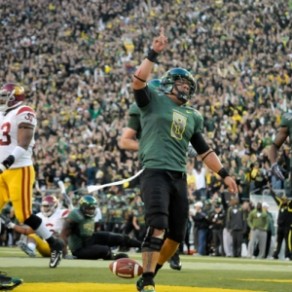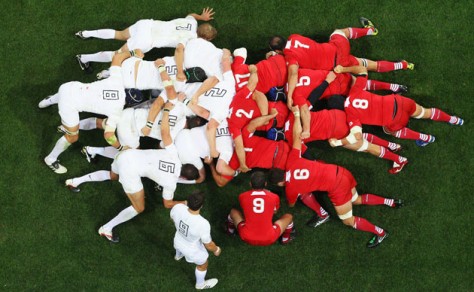It’s 2013, and statistics are ubiquitous in college football: yards per play, 3rd down conversion rate, points per game, defensive efficiency, time of possession, attractiveness of fake girlfriends, turnover margin, blah blah blah blah. We’ve got all kinds of “objective” statistical methods to “measure” how “good” a football team “is.” This clearly ain’t Knute Rockne’s football.
The problem with all these objective measures is: football is not objective! You cannot compare stats, scores, indexes, or any other numbers to predict how one team will do against another team! We see this time and time again; the pundits quote stats, use those stats to come to conclusions or predictions, and then get it completely wrong. (I am not at all referring to Lou Holtz.)
No, friends: football is the most subjective of games: how do teams respond to an opponent score? Hostile environments? Inclement weather? Unfortunate turnovers? Shootouts? Defensive battles? Having their plays called by Jeff Tedford? (One of those factors has limited applicability.)
The task of measuring “goodness” becomes extraordinarily difficult once we consider those subjective factors.
So, what’s the purest measure of how “good” a team is? It’s not time of possession, not margin of victory, not points per game. Think simpler! What’s the primary purpose of football? SCORE MORE POINTS THAN THE OTHER GUY. (Oh, and beat ‘SC.)
“Now, Sean,” some of you might say, “isn’t that just measuring margin of victory?” No, not really. You and I know that different teams, conferences, and regions have different theories on how to play the game, and different levels of points are scored as a result: Oregon’s point-a-minute-win-by-a-lot game versus Notre Dame’s ground-and-pound-win-by-a-few is a good example. (Even as a tremendous Oregon homer, I admit that there’s an art to slugging out that 10-7 victory. I just would rather poke needles in my eyes than watch it.)
“So, Sean,” you say, “what’s your genius way to compare teams based on ‘scoring more points than the other guy?'” Firstly, stop asking so many questions. Secondly, it’s a little thing I like to call THE TEAM EFFICIENCY INDEX. The most basic explanation of the Index is the ratio of points scored to points allowed, or (Total Points Scored / Total Points Allowed) = TEAM EFFICIENCY INDEX (or TIE).
This ratio carried over an entire season demonstrates the responsiveness of a team: can a team score after scored upon? Respond to other adversities? Maintain a lead? Build a lead? This, as explained above, is different than straight-up margin of victory. A 14-7 victory can be just as impressive an outing as a 34-17 victory. In the close game, your offense needs to play field position, and your defense needs to get every stop possible. In the “shootout,” your offense has to score and score some more, and your defense needs to get a stop approximately two out of every three possessions. But both game plans are designed to do the same thing: maintain the points ratio!
I admit that the TIE is not perfect. It does not adequately reward teams for winning good close games, gives more weight to blowouts over cupcakes, and has no regard for strength of schedule. But since we still have five months until college football kicks off, we can use some fodder for debate, can’t we?
And if you REALLY have a problem with it, go ahead and make your own index.
Without further ado, here is the TEAM EFFICIENCY INDEX for the AP Top 25 from the finish of last season, reordered to reflect each team’s TIE:
|
Team (AP), (Record) |
Points Scored
|
Points Allowed
|
Team Efficiency Index |
|
|
Fewest Points Allowed |
1. Alabama (1), (13-1) |
542 |
153 |
3.54 |
|
2. Florida State (10), (12-2) |
550 |
206 |
2.67 |
|
|
Most Points Scored |
3. Oregon (2), (12-1) |
645 |
281 |
2.29 |
|
|
4. Utah State (16), (11-2) |
454 |
200 |
2.27 |
|
|
5. Texas A&M (5, tie), (11-2) |
578 |
283 |
2.04 |
|
Fewest Points Scored |
6. Notre Dame (4), (12-1) |
335 |
166 |
2.02 |
|
|
7. Northern Illinois (22), (12-2) |
540 |
278 |
1.94 |
|
|
8. Georgia (5, tie), (12-2) |
529 |
275 |
1.92 |
|
|
9. Boise State (18), (11-2) |
393 |
205 |
1.92 |
|
|
10. Florida (9), (11-2) |
344 |
188 |
1.83 |
|
|
11. Kansas State (12), (11-2) |
505 |
288 |
1.75 |
|
12. South Carolina (8), (11-2) |
410 |
237 |
1.73 |
|
|
|
13. LSU (14), (10-3) |
387 |
228 |
1.70 |
|
14. Clemson (11), (11-2) |
533 |
323 |
1.65 |
|
|
15. Ohio State (3), (12-0) |
446 |
274 |
1.63 |
|
|
16. San Jose State (21), (11-2) |
452 |
277 |
1.63 |
|
|
17. Stanford (7), (12-2) |
390 |
241 |
1.62 |
|
|
18. Vanderbilt (23), (9-4) |
390 |
243 |
1.60 |
|
|
19. Oregon State (20), (9-4) |
423 |
268 |
1.58 |
|
|
20. Oklahoma (15), 10-3) |
496 |
331 |
1.50 |
|
|
21. Michigan (24), (8-5) |
388 |
258 |
1.50 |
|
|
22. Northwestern (17), (10-3) |
412 |
293 |
1.41 |
|
|
|
23. Louisville (13), (11-2) |
405 |
309 |
1.31 |
|
Most Points Allowed |
24. Nebraska (25), (10-4) |
487 |
386 |
1.26 |
|
|
25. Texas (19), (9-4) |
464 |
380 |
1.22 |
So, conclusions?
A. The Ducks’ numbers are (surprise!) really, really good. The Ducks scored 67 more points than the second-best scoring team in the AP Top 25: Texas A&M. This contributed to their #3 overall TIE of 2.29, and took the phrase, “The best defense is a good offense,” to a whole new level.
B. Alabama completely dominated people. Though it pains me to say it, scoring more than three-and-a-half times as often as your opponents is damn impressive. Damn you, Saban!
C. Ohio State and Stanford were the most overvalued by the AP rankings (3rd, 7th) compared to the Team Efficiency Index (15th, 17th). This may be explained by the fact that both teams won very close games that voters loved to watch. Also, both teams played VERY clutch down the stretch: Ohio State winning at Camp Randall and beating Michigan to go 12-0; Stanford beating Oregon State, Oregon (single tear), UCLA (twice), and Wisconsin en route to a Rose Bowl title.
D. Utah State, Northern Illinois, and Boise State were the most overvalued by the Team Efficiency Index (4th, 7th, 9th) compared to the AP rankings (16th, 22nd, 18th). This may be most simply explained by the conferences that they play in, as success in the WAC, MAC, and Mountain West is not considered on the same plane as success in the “power” conferences.” But their TIE is competitive with anyone in the country.
E. Some Top 25 teams (Louisville, Nebraska, Texas) BARELY outscored their opponents. Scoring 31%, 26%, or 22% more than your opponents is not exactly dominant. But these teams got the wins they needed.
Thanks for walking with me along the path to statistical enlightenment. Tell me what I got wrong, where my analysis misses, and what sticks out to you in this Team Efficiency Index system in the comments. After all, we can use the distraction and debate during the long offseason!
Related Articles:
With a high school defensive-coordinator-turned-offensive-coordinator-turned-head-coach as a father, Sean Goodbody has always had an interest in the X’s and O’s of football. He played two years with FCS University of Pennsylvania as a fullback, but having grown up in a football family Sean has spent much of his life studying the game–reviewing game film, designing offensive and defensive schemes, and game-planning upcoming opponents.
Sean has coached running backs, option quarterbacks, linebackers, defensive linemen, and safeties for his dad’s high school program. He has been a rabid Duck fan since meeting his significant other Maeve (an Oregon grad). Residing in Grand Junction, CO, Sean and Maeve both work as attorneys while cheering on their beloved Ducks from the Rockies.






